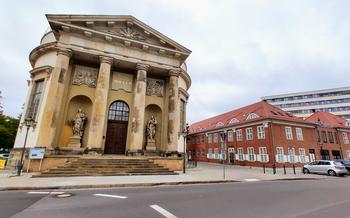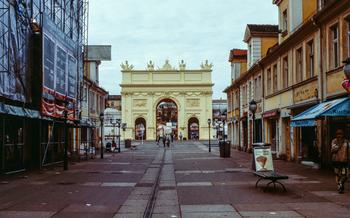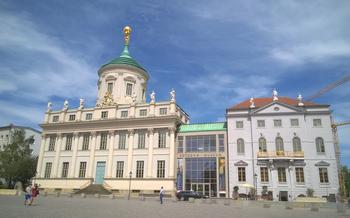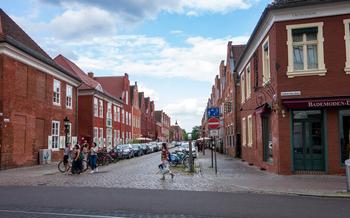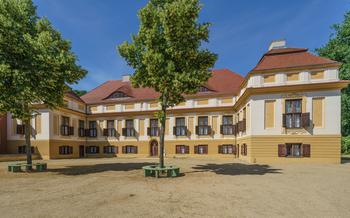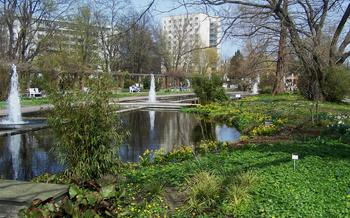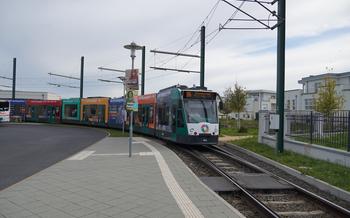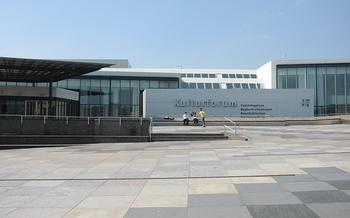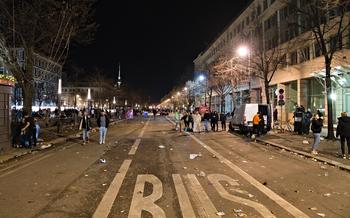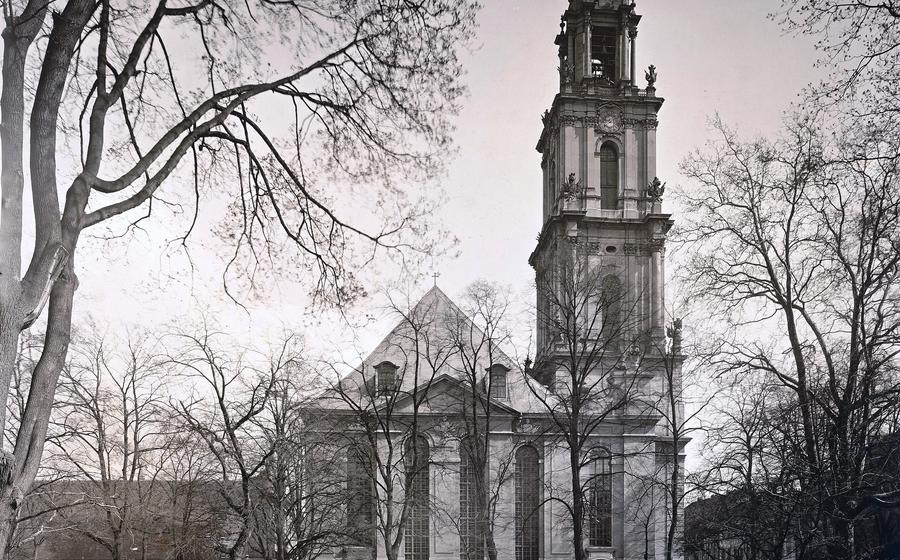
The Memorial Site Leistikowstraße Potsdam
- The Memorial Site Leistikowstraße Potsdam
- Location and Accessibility
- Hours of Operation and Admission Fees
- Architecture and Design
- Exhibitions and Installations
- Educational and Commemorative Programs
- The Significance of the Memorial Site
- Personal Reflections
- Practical Tips for Visitors
- Nearby Attractions
- Getting Around Potsdam
- Insider Tip
The Memorial Site Leistikowstraße Potsdam
The Memorial Site Leistikowstraße Potsdam is a poignant reminder of the dark chapters in German history. Located in the heart of Potsdam, the former prison served as a place of detention and torture during the Nazi regime and later under the Soviet occupation. Today, it stands as a memorial to the victims of political persecution and a testament to the resilience of the human spirit.
The memorial site encompasses the original prison building, a new memorial building, and a landscaped courtyard. The prison building has been preserved in its original state, providing a glimpse into the harsh conditions faced by the inmates. The new memorial building houses permanent and temporary exhibitions, as well as educational and commemorative spaces. The interplay of architecture and history creates a powerful and thought-provoking experience for visitors.
Location and Accessibility
The Memorial Site Leistikowstraße Potsdam is conveniently located in the heart of Potsdam, within easy reach of public transportation and other attractions. The address of the memorial site is Leistikowstraße 1, 14467 Potsdam, Germany. To get there by public transportation, you can take the S-Bahn (S7 or S9) to the Potsdam Hauptbahnhof station and then take bus 695 to the Leistikowstraße stop. The memorial site is also accessible by car, with limited parking available on-site. For visitors with disabilities, the memorial site is fully accessible, with ramps, elevators, and wheelchair-accessible restrooms.
Hours of Operation and Admission Fees
The Memorial Site Leistikowstraße Potsdam is open to the public from Tuesday to Sunday. The regular hours of operation are from 10:00 am to 6:00 pm. However, there may be special hours during events or holidays, so it is advisable to check the website or call ahead to confirm.
Admission to the memorial site is free of charge. Guided tours are available in German and English and cost 3 euros per person. Discounts are available for groups of 10 or more people. Guided tours can be booked in advance by phone or email.
The memorial site also offers a range of educational programs, workshops, and seminars for students and educators. These programs are designed to promote understanding of the history of the prison and its significance in German history. Fees for these programs vary depending on the type and duration of the program.
Architecture and Design
The original prison building, constructed in the 19th century, is a somber and imposing structure. Its thick walls, barred windows, and heavy iron gates convey a sense of isolation and confinement. The new memorial building, added in 2005, is a stark contrast to the original. Its modern, minimalist design features glass and steel elements, creating a sense of openness and transparency. The interplay of the old and new buildings symbolizes the tension between the dark past and the hopeful present.
The memorial site also incorporates a number of symbolic elements. The courtyard, where prisoners were once forced to exercise, is now a place of remembrance. A memorial wall lists the names of over 1,000 victims who were imprisoned or executed at Leistikowstraße. A sculpture by the artist Christian Boltanski, entitled "Menschenberg" (Mountain of People), consists of thousands of small metal figures arranged in a pile. The sculpture represents the countless victims of political repression who were lost to history.
Exhibitions and Installations
The Memorial Site Leistikowstraße Potsdam features a range of permanent and temporary exhibitions that explore the history of the prison and its significance in German history. The permanent exhibitions provide a comprehensive overview of the prison's role during the Nazi regime and the Soviet occupation, shedding light on the experiences of the prisoners and the perpetrators.
Visitors can learn about the daily life of the prisoners, the harsh conditions they endured, and the various forms of torture and abuse they were subjected to. The exhibitions also highlight the resistance efforts of the prisoners and their attempts to maintain a sense of humanity amidst the horrors of the prison.
Temporary exhibitions at the memorial site focus on specific aspects of the prison's history or related topics. These exhibitions often feature works of art, photography, and multimedia displays that offer unique perspectives on the past. The use of interactive installations and multimedia technology enhances the visitor experience, allowing them to engage with the material in a more immersive way.
Through its exhibitions and installations, the Memorial Site Leistikowstraße Potsdam aims to convey the historical narratives of the prison, honor the victims, and promote a deeper understanding of this dark chapter in German history.
Educational and Commemorative Programs
The Memorial Site Leistikowstraße Potsdam offers a range of educational and commemorative programs to promote remembrance, understanding, and reconciliation. Guided tours for individuals and groups provide visitors with in-depth insights into the history of the prison and its significance in German history. These tours are led by experienced guides who share their knowledge and research on the site.
Workshops and seminars for students and educators are also conducted at the memorial site. These programs focus on topics such as the history of the prison, the lives of the victims, and the broader context of the Nazi regime and the Cold War. The workshops aim to foster critical thinking, empathy, and historical understanding among participants.
Commemorative events and ceremonies are held throughout the year to honor the victims of Leistikowstraße and to promote reconciliation. These events often include speeches, readings, and musical performances. They provide an opportunity for visitors to reflect on the past and to come together in remembrance.
The memorial site also offers opportunities for research and documentation. Researchers and scholars can access the site's extensive archives, which contain documents, photographs, and personal accounts related to the prison. This material is available for research and publication, contributing to the ongoing study and understanding of this dark chapter in German history.
The Significance of the Memorial Site
The Memorial Site Leistikowstraße Potsdam stands as a profound testament to the dark chapters of German history and serves as a vital space for remembrance, reconciliation, and education. Through its exhibitions, installations, and educational programs, the memorial site plays a crucial role in preserving the memory of the victims of political oppression and promoting a deeper understanding of the atrocities committed during the Nazi regime and the Soviet occupation.
The memorial site's existence is a testament to the resilience and determination of those who survived the horrors of Leistikowstraße prison and the countless others who have dedicated their lives to ensuring that the victims are never forgotten. It serves as a poignant reminder of the fragility of human rights and the importance of upholding justice and human dignity in the face of adversity.
Beyond its role in preserving historical memory, the memorial site contributes significantly to reconciliation and healing within German society. By providing a platform for dialogue and understanding, it helps to bridge the gaps created by the deep wounds of the past and fosters a sense of collective responsibility for confronting and overcoming the legacy of oppression.
Moreover, the memorial site serves as a powerful educational tool, particularly for younger generations. Through guided tours, workshops, and commemorative events, it provides a unique opportunity for students and educators to engage with the history of the prison and its victims, fostering critical thinking, empathy, and a commitment to preventing such atrocities from happening again.
Ultimately, the Memorial Site Leistikowstraße Potsdam stands as a symbol of resistance and hope, demonstrating the enduring power of the human spirit in the face of oppression. It is a place where the past is confronted, lessons are learned, and a better future is envisioned, ensuring that the legacy of the victims continues to inspire and guide generations to come.
Personal Reflections
My visit to the Memorial Site Leistikowstraße Potsdam was a profound and moving experience. As I walked through the former prison cells, I was overwhelmed by a sense of history and the suffering that had taken place within these walls. The personal stories of the victims, displayed in the permanent exhibitions, brought the horrors of the Nazi regime and the Soviet occupation to life. The site served as a powerful reminder of the importance of preserving historical memory and fighting against all forms of tyranny and oppression.
The memorial site also evoked a sense of hope and resilience. It stands as a testament to the strength and courage of those who survived the atrocities committed at Leistikowstraße. Their stories of resistance and survival serve as an inspiration to us all and remind us of the indomitable spirit of the human will.
As I left the memorial site, I felt a deep sense of gratitude for the opportunity to learn about this dark chapter in German history. The site has played a vital role in promoting reconciliation and healing and serves as a powerful reminder of the importance of human rights and the fight against injustice.
Practical Tips for Visitors
To make the most of your visit to the Memorial Site Leistikowstraße Potsdam, plan to spend at least two hours exploring the exhibitions and installations. The site is wheelchair accessible, with ramps and elevators throughout. Restrooms and a small café are available on the premises. For photography enthusiasts, tripods are permitted for personal use, but flash photography is not allowed.
To fully appreciate the significance of the memorial site, consider booking a guided tour. Tours are available in German and English and provide valuable insights into the history of the prison and the experiences of the victims. Visitors can also participate in educational workshops and seminars, which offer a deeper understanding of the site's themes.
To combine your visit to the Memorial Site Leistikowstraße with other attractions in Potsdam, consider purchasing a Potsdam Pass. This pass grants you free or discounted admission to over 20 museums and attractions, including the Brandenburg Gate, the Sanssouci Palace, and the Gardens of the World. The pass also includes unlimited use of public transportation, making it easy to explore the city.
Nearby Attractions
Potsdam is a city rich in history and culture, offering a plethora of attractions for visitors to explore. Just a short distance from the Memorial Site Leistikowstraße, you can find several iconic landmarks and cultural institutions that are worth visiting.
-
The Brandenburg Gate: This monumental gate is one of the most recognizable symbols of Germany and a must-see attraction for any visitor to Potsdam. It was built in the 18th century and served as a symbol of Prussian power and military might. Today, it stands as a symbol of German unity and is a popular spot for tourists and locals alike.
-
The Sanssouci Palace: This magnificent palace was built in the 18th century as a summer residence for the Prussian king Frederick the Great. It is considered one of the finest examples of Rococo architecture and is surrounded by beautiful gardens and parks. The palace is open to the public and offers guided tours that provide insights into the life and times of Frederick the Great.
-
The Gardens of the World: This unique park features gardens inspired by different cultures from around the world. Visitors can stroll through Chinese, Japanese, Italian, and Balinese gardens, each offering its own unique charm and beauty. The park also hosts various events and festivals throughout the year, making it a great destination for families and nature enthusiasts.
-
The Dutch Quarter: This historic neighborhood is characterized by its charming red-brick houses and narrow streets. It was built in the 18th century by Dutch immigrants who were invited by Frederick the Great to settle in Potsdam. Today, the Dutch Quarter is a popular tourist destination, offering a glimpse into the city's rich history and culture.
-
The Film Museum Potsdam: This museum is dedicated to the history and art of filmmaking. It houses a collection of over 20,000 films, as well as exhibits on the history of cinema, film production, and film technology. The museum also hosts regular screenings and events, making it a great destination for film buffs and enthusiasts.
Getting Around Potsdam
Potsdam offers a variety of convenient transportation options to explore the city and its attractions. The efficient öffentlichen Nahverkehr (ÖPNV) network, consisting of buses and trams, connects all major points of interest. Single tickets, day passes, and multi-day passes are available, providing affordable options for visitors.
For those who prefer a more active mode of transportation, bike rental is a popular choice. Several bike rental shops are located throughout the city, offering a range of bicycles to suit different needs and preferences. Cycling is a great way to explore Potsdam's many bike paths and scenic routes, including the Havel Cycle Path.
Taxis and ride-sharing services are also readily available in Potsdam, providing a convenient and comfortable way to get around the city. Fares are generally reasonable, and many taxi companies offer fixed rates for popular routes.
For those who enjoy exploring on foot, Potsdam is a pedestrian-friendly city with many attractions located within walking distance of each other. The city center, in particular, is easily navigable on foot, allowing visitors to soak in the historical atmosphere and admire the charming architecture.
Insider Tip
To fully immerse yourself in the history of the Memorial Site Leistikowstraße Potsdam, consider visiting during the off-season or on a weekday to avoid the crowds and create a more intimate and reflective experience. Take advantage of the opportunity to engage in meaningful conversations with the knowledgeable staff or docents, who can provide insights into the site's history and significance.
Before your visit, delve deeper into the subject matter by reading books like "The Leistikowstraße Prison: A History of Terror and Resistance" or "The Victims of Leistikowstraße: Stories of Courage and Resilience." These publications offer a comprehensive understanding of the site's past and the lives of those who suffered within its walls.
If you're interested in volunteering or getting involved with the memorial site, inquire about opportunities to contribute to their mission of preserving historical memory and promoting reconciliation. Your participation can make a meaningful impact on the site's operations and its ability to educate and inspire future generations.
